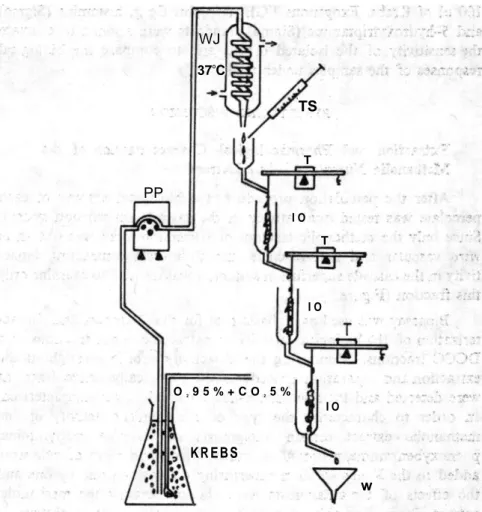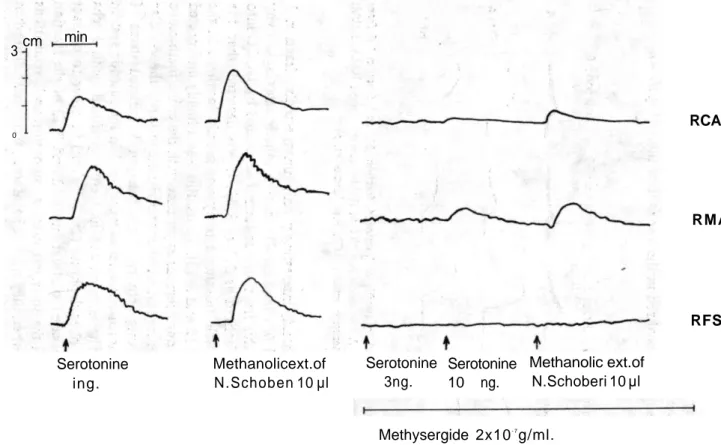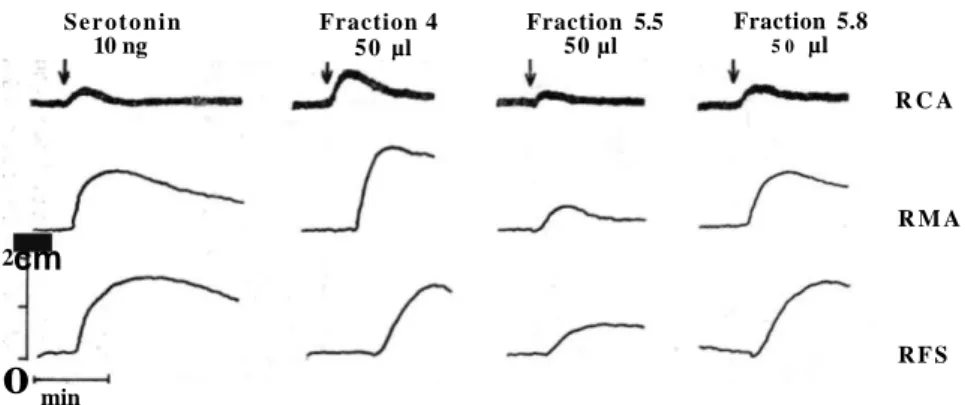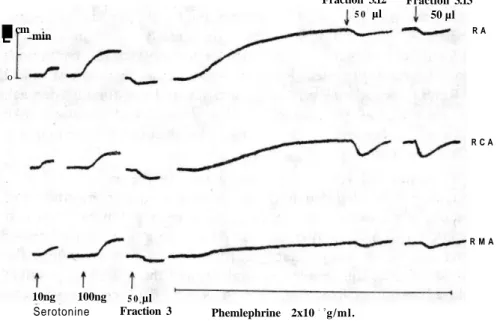18, 1 (1988) 18, 1 (1988)
Pharmacological Activity of The Extracts of Nitraria Schoberi (Zygophyllaceae)
Nitraria Schoberi (Zygophyllaceae) Ekstrelerinin Farmakolojik Aktiviteleri Üzerine Araştırmalar
Levent ÜSTÜNES*
SUMMARY
Nitraria schoberi (Zygophyllaceae) is a promising member of the plant kingdom for new bioactive principles.
Three fractions, two with serotonin-like activity and one with vascular smooth muscle relaxing activity were isolated from this plant. Cascade superfusion bioassay system with rabbit aorta, coeliac and mesenteric arteries and rat fundus stomach strip were used for the bioassay in order to detect and characterize the pharmacological acti-vity of the fractions. The results indicate that Nitraria schoberi yields some pharmacologically active substances and this report is the first in literature about the pharmacological activity of the plant.
ÖZET
Nitraria schoberi (Zygophyllaceae) yeni biyoaktif maddelere kay-nak oluşturma potansiyeli bakımından bitkiler aleminin ümit veren bir üyesidir. Bitkiden üç ayrı fraksiyon izole edilmiş ve yapılan biyo-lojik aktivite testleri sonucunda bu fraksiyonlardan ikisinin serotonin benzeri aktivite gösterirken diğerinin de vasküler düz kas gevşetici
Redaksiyona verildiği tarih: 20.4.1988
* Department of Pharmacology, Faculty of Pharmacy, Ege University, İzmir-TURKEY
Pharmacological Activity of The Extracts. 75 bir etkiye sahip olduğu belirlenmiştir. Fraksiyonların farmakolojik aktivitelerinin saptanması ve karakterize edilmesi amacıyla izole organ kaskat süperfüzyon sistemi kullanılmış ve bu sistemde tavşan aortası, tavşan söliyak ve mezanterik arterleri ile gerektiğinde sıçan mide fundus şeridi kombine edilerek kullanılmışlardır. Araştırma sonuçlan Nitraria schoberi bitkisinin güçlü farmakolojik aktivite gösteren ümit verici bazı maddeler içerdiğini ortaya koymaktadır. Bu araştırma ma-kalesi aynı zamanda Nitraria schoberi bitkisinin farmakolojik aktivi-tesiyle ilgili literatürde beliren ilk rapordur.
Key Words: Zygophyllaceae, Nitraria schoberi, Pharmacological activity, Serotonin-like activity, Nitrarine, Nitramidine, Serotonin.
General studies on detection, isolation and structure determination of new bioactive principles from natural sources is systematically searching for some less known but hopefull plant origin members. Nitraria schoberi (Zygophyllaceae) is an unknown plant for its phar-macological activity and is widely distributed all over Asia, Turkey and the Middle East. Therefore different solvent fractions obtained from this plant was worth to be under-taken into a pharmacological screening program. This paper deals with pharmacological characteri-zation of different fractions obtained from dried Nitraria schoberi.
MATERIALS AND METHODS Nitraria schoberi samples
Nitraria schoberi samples used in this study were collected as a whole plant from the Middle Anatolia Region in Turkey. The samples were dried without exposure to direct light and were powdered.
Crude Extracts
In order to screen the biological activity of Nitraria schoberi a percolation procedure was started with different solvents on the order of increasing polarity . 500 g dried and powdered sample was percolated with petroleum ether (3 1), toluen (3 1), diethy ether (3 1), ethyl acetate (3 1) and methanol (3 1) in a glass percolator (75 x 6 cm). Each perco-late was evaporated to dryness under water pump pressure at a
tempe-rature not exceeding 40°C. The residues were kept -20°C until they were tested. The biological activity of each of these extracts was
de-termined qualitatively in a cascade superfusion bioassay system in which the isolated rabbit coeliac, mesenteric arteries and the rat stomach fundus strip were used as assay organs.
Further Extraction and Fractionation of Bioactive Methanol Extract
Since preliminary experiments showed that only methanolic ex-tract of the plant displayed serotonin-like bioactivity the methanol extract was further fractionated by solvent-solvent partition (Figure 1). A total of 7 fractions were obtained by this procedure and fraction 2, 3 and 5 were further separated. Fraction 2 (± 290 mg) and Fraction 3 (± 350 mg) were further separated by droplet counter-current chro-matography (DCCC) separately. The apparatus for D C C C was an Eyela Apparatus (Tokyo Rikakikai Co., Ltd., Tokyo, Japan) and con-sisted of pyrex glass tubes that are stable acids, alkalis and other sol-vents. The solvent system of chloroform-methanol-propanol-water (5:6:1:4) that form two immicible layers are selected for the efficient separation of compounds by D C C C . Before starting the developments all of the tubes were filled with the upper layer of the solvent system to make a stationary phase and the lower layer of the solvent system was used as a descending mobile phase. The fractions to be separated were dissolved in the mobile phase and charged to the sample chamber. The end of the system was connected to a fraction collector to collect 20 ml fractions. In this way, fraction 2 was further separated and 277 fractions of 20 ml were collected. Monitoring was done by thin layer chromatography analyses of every third fraction (l0 µl aliquots, Sili-cagel 60 F 254, 20x20 cm, 0 . 2 mm, Merck) in ethyl acetate-methanol -water (100:17:13). Spots were located before and after spraying with diphenylboric acid ethanolamine by U V3 6 6 illumination. These fractions which showed identical patterns were combined and evapo-rated to dryness and 10 subfractions of fraction 2 were obrtained. Fraction 3 was also further separated by D C C C and 261 fractions of 20 ml were collected. These fractions were also monitored as descri-bed above. The fractions having identical patterns were combined and evaporated to dryness and 13 subfractions of fraction 3 were obtained.
Pharmacological Activity of The Extracts... 77
FRACTION 6 Dissolved in 0.1 N HCl and
extracted with CHCl3 (3x200 ml) CHC1, - Extract FRACTION 1 ± 270 mg Acid - H20 Extract Extraction with ethyl acetate (5x200 ml) Acid - H , 0 Extract Acid - H2O Extract
Extraction with methyl ethyl keton (5x200 ml)
Ethyl acetate Extract
FRACTION 2 ± 290 mg
+ N H3, pH 10
Extraction with CHC13
(5x200 ml)
Methyl ethyl keton Extract
FRACTION 3 + ± 350 mg CHC1, - Extract FRACTION 4x ± 45 mg Precipitation FRACTION 7 ± 35 mg Basic - H20 Extract FRACTION 5x ± 9 g Fig. 1. Extraction of the methanolic extract of Nitraria schoberi.
( + ) Fraction showing vascular smooth muscle relaxing activity
(x) Fraction showing vascular and non-vascular smooth muscle contracting activity (so-called serotonin-like activity)
METHANOLIC EXTRACT OF NITRARIA SCHOBERI (10 g)
Finally all these subfractions obtained from fraction 2 and fraction 3 were tested in the cascade superfusion bioassay system.
Fraction 5 ( ± 9 g) was separated on a Sephadex LH-20 column (100 g; 52x3 cm). The column was developed with a gradient of increas-ing percent of methanol changincreas-ing to methanol-acetone (1:1). 116 Fractions of 20 ml were collected (LKB 7000 Ultrarac Fraction Collec-tor), and monitoring was done by thin layer chromatography analyses of every third fraction (l0 µl aliquot, Cellulose plates, 20x20 cm, 0.2 mm, Merck) in 10 % acetic acid 5 cm and 6 % acetic acid 14 cm. Spots were located before and after spraying with diphenylboric acid ethanolamine by U V3 6 6 illumination. The fractions which showed identical patterns were combined and evaporated to dryness and finally pharmacologically tested in the cascade superfusion bioassay system.
Continuous Cascade Seperfusion System
To detect the biological activity of extracts, column fractions and the D C C C subfractions, a cascade system of isolated organs were used (Figure 2), (2). Rabbit of either sex ( 2 . 5 - 3 kg, Dendermondse Witte) were killed by a blow on the head, bled and the aorta, coeliac and me-senteric arteries removed. These arteries were cut spirally, whereas the rat fundus strip (Wistar rats of either sex, 200-300 g) was prepared by zigzag cutting (3-5). The tissues were fixed in a cascade system and a load of 3 g was applied. The isolated organs were superfused by means of a Gilson Minipuls II roller pump at a rate of 5 ml /min. The super-fusion fluid was Krebs with the following composition in g /ml ( m M ) : NaCl, 6.9 (118); KCl, 0.35 ( 4 . 7 ) ; C a C l2. 2 H2O , 0.55 ( 2 . 5 ) ; K2H P O4, 0.16 ( 1 . 2 ) ; M g S O4. 7 H2O , 0.29 (1.17); glucose, 2 . 0 (11.1); N a H C O3, 2 . 1 (25.0). The following antagonists were added to the Krebs solu-tion (final concentrasolu-tions) when it was necessary (6): Atropine (Merck;
1 0- 6 g / m l ) , methysergide maleate (Sandoz; 2 x 1 0- 7g / m l ) , mepyra-mine maleate (Baker; 1 x 1 0- 7g / m l ) , phenoxybenzamine (Smith, Kline and French; 1x10- 7 g/ml), propranolol hydrochloride (imperial Chemical Incorporation; 2 x l 0- 6 g/ml) and indomethacin (Merck, Sharp and D o h m e ; 1x10- 6 g /ml). Phenylephrine (Sigma; 2 x 1 0- 7 g /ml) in supervising Krebs solution was used in order to contract the
Pharmacological Activity of The Extracts. .
Fig. 2. Schematic drawings of the cascade superfusion system (WJ, Warming jacket; TS, Test substance; T, Transducer; 10, Isolated organ; PP, Constant volume perfusion
pump; W, Waste material).
arteries for the detection of vascular smooth muscle relaxing activity of Nitraria schoberi fractions (7).
The contractions of the organs were auxotonically detected by Harvard smooth muscle transducers and recorded with a Watanabe 6-channel recorder. All extracts and fractions from the sephadex column chromatography and D C C C were tested on the cascade. For this purpose, 0.15 ml of samples were employed, evaporated until solvent free under a stream of nitrogen a n d the residue dissolved in
79 O29 5 % + C O25 % I O K R E B S w I O WJ PP T TS 37OC I O T
100 µl of Krebs. Exogenous P G E2 (Upjohn Co.,), histamine (Sigma) and 5-hydroxytriptamine (Sigma) standarts were applied to evaluate the sensitivity of the isolated organs and to compare the biological responses of the samples under trial.
RESULTS A N D DISCUSSION
Extraction and Pharmacological Characterization of the Methanolic Nitraria schoberi Extract
After the percolation procedure, the biological activity of each percolate was tested qualitatively in the cascade supervision system. Since only the methanolic fraction of Nitraria schoberi showed an in vitro vascular and non-vascular smooth muscle contracting bioac-tivity in the cascade superfusion system, it was decided to examine only this fraction (Figure 3 ) .
Bioassay was used as a basic tool for the detection and charac-terization of the biological activity of extracts, column fractions and D C C C fractions. Monitoring the bioactivity profile throughout the extraction and separation procedures, the biologically active fractions were detected and their serotonin-like bioactivity was characterized. In order to characterize the type of the agonistic activity of the methanolic extract certain antagonists i.e. atropine, mepyramine, phenoxybenzamine, propranolol, indomethacin and methysergide were added to the Krebs solution supervising the cascade one by one and the effects of the antagonists were checked against the methanolic extract. Proceeding this procedure, it was shown that methysergide which is a spesific antagonist of serotonin was the only antagonist inhibiting in vitro vascular and non-vascular smooth muscle cont-racting bioactivity (so-called serotonin-like activity) of the methanolic extract in the cascade superfusion bioassay system (Figure 3 ) .
Further Separation of the Bioactive Methanolic Extract
For further separation of the methanolic extract a conventional solvent extraction procedure was used and seven fractions symbolized as 1 to 7 were obtained. All of these fractions were tested on the cas-cade and it was detected that serotonin-like activity localized in
frac-Serotonine ing.
Fig. 3. Biological activity profile of the methanolic fraction of Nitrarla schoberi in the cascade superfusion system (so-called seratonin-like activity) (RCA, Rabbit coeliac artery; RMA, Rabbit mesenteric artery; RFS, Rat fundus strip).
RCA Methanolicext.of N.Schoben 10 µl Serotonine 3ng. Serotonine 10 ng. Methanolic ext.of N.Schoberi 10 µl RMA RFS cm min 3 0 Methysergide 2x10- 7g/ml.
tion 4 (± 45 mg) and fraction 5 (± 9 g). The fraction 5 was further separated by Sephadex L H - 2 0 column chromatography into 8 sub-fractions symbolized 5.1 to 5.8 and it was shown that serotonin-like activity was mainly localized in the last four of them (Figure 4).
Fraction 5.5 50 µl Fraction 5.8 5 0 µl R C A R M A R F S min
Fig. 4. Serotonin-like activity profile of fraction 4, fraction 5.5 and fraction 5.8 from the methanolic extract of Nitraria schoberi (RCA, Rabbit coeliac artery; RMA, Rabbit
mesenteric artery; RFS, Rat fundus strip).
On the other hand, interestingly and unexpectedly, fraction 3 (± 350 mg) showed in vitro vascular smooth muscle relaxing activity on the cascade and this fraction was further separated by D C C C into 13 subfractions symbolized as 3.1 to 3.13. It was detected that the vascular smooth muscle relaxing activity was mainly localized in the last two fractions (3.12 and 3.13). To us, this was a highly unexpected response because of our previous experience with the crude methanolic extract and we therefore ran another experiment to verify the vascular smooth muscle relaxing activity of the fraction 3. Isolated strips of aorta, coeliac and mesenteric arteries were fixed in the cascade system for this purpose. The isolated organs were superfused with Krebs solution containing phenylephrine ( 2 x 1 0- 7 g/ml) in order to conract the tissues. The separated subfractions 3.12 and 3.13 of the fraction 3, which had shown the strongest vascular smooth muscle relaxations of the helical strips when they were at basal tone, were controlled when contracted with phenylephrine. As expected, the strips which were
Fraction 4 50 µl S e r o t o n i n 10 ng
cm
2o
Pharmacological Activity of The Extracts. 83
already contracted with phenylephrine were relaxed in response to subfractions 3.12 and 3.13 of the fraction 3 (Figure 5).
Fig. 5. The relaxing effects of the fraction 3 and its subfractions 3.12 and 3.13 from the methanolic extract of Nitraria schoberi. The isolated organs were superfused with Krebs
solution containing phenylephrine ( 2 x l 0- 7 g/ml) in ortder to contract the tissues (RA,
Rabbit aorta; RCA, Rabbit coeliac artery; RMA, Rabbit mesenteric artery).
Other fractions e.g. fraction 1, fraction 2, fraction 6 and fraction 7 were also controlled for the bioactivity on the same system but no considerable amount of bioactivity was detected.
Several methods for screening of plant extracts have been dis-cussed in literature. Phytochemical screening (8) or Hyppocratic and pharmacodynamic screening (9, 10) might be used. As already men-tioned by Thorp (11), a close cooperation between pharmacognosists and pharmacologists is necessary.
Despite the advent of more selective techniques, such as radioim-munoassay and mass spectrometry, bioassay is widely used for the identification of biologically active substances. The technique of
Fraction 3.12 Fraction 3.13 5 0 µl 50 µl cm min
E
o 10ng 100ng 5 0 µl R A R C A R M A Phemlephrine 2x10 - 7g/ml. Fraction 3 Serotonineisolated organ superfusion was first described by Finkelman (12) and developed by Gaddum (13) for the detection of biologically active sub-stances. Later the method was modified by Armitage and Vane (14) for the simultaneous use of more than one assay preparation. Since the adaptation of the superfusion technique for the detection of active materials in plant extracts has been particularly useful in isolation and identification of bioactive principles from plants(15), continuous cascade superfusion system has been chosen as an in vitro test model (2). Rabbit coeliac and mesenteric arteries and rat fundus stomach strip were used as test organs in this system and serotonin-like bioactivity of Nitraria schoberi extract were documented qualitatively for the first time.
Serotonin has a widespread occurence. In the animal kingdom, serotonin can be detected both in vertebrates and in invertebrates. In plants, it is present in edible fruits and vegetables but has been also associated with poisonous species(16). The finding that our methanolic extract and one of its fractions i.e. fraction 4, mainly containing the alkaloids of the plant (tested for alkaloids and the result was positive) displayed serotonin-like bioactivity in in vitro bioassay preparations is also in agreement with the recent results obtained by Ibragimov et al (17, 18). These investigators previously reported that Nitraria schoberi containes two indole alkaloids, nitrarine and nitramidine which are related chemically to the structure of serotonin because of their indole structures (Figure 5). The existance of these two indol alkaloids in the plant does not exclude the probability of the presence of serotonin itself in the plant and our preliminary qualitative high performance liquid chromatography (HPLC) analyses performed by authentic serotonin standart and the Nitraria schoberi extracts showing seroto-nin-like bioactivity on the cascade supports this possibility (person-nel observation of the investigator).
On the other hand, interestingly and highly unexpectedly, one of the other separated fractions of the methanolic extract i.e. fraction 3, showed vascular smooth muscle relaxing activity when the isolated blood vessels were at basal tone on the cascade. Therefore, it was plan-ned to perform another experiment in order to clearify the responses of this fraction. Fraction 3 was further fractionated by D C C C for this purpose and its subfractions showing vascular smooth muscle relaxing
Pharmacological Activity of The Extracts.
Fig. 6. Nitramidine and Nitrarine. Two indol alkaloids which were previously isolated from Nitraria schoberi (17, 18).
activity at basal tone were detected. The separated bioactive subfrac-tions 3.12 and 3.13 of the fraction 3 were further investigated when the isolated blood vessels were precontracted by phenylephrine in order to increase their tonus and it has been proved that the strips showed the expected relaxations in response to these fractions, whereas the other subfractions of the fraction 3 showed no relaxation. Because only a small amount of fraction 3 had already been obtained and since this is a preliminary study chemical nature of this fraction was not in vestigated. But present findings clearly indicate that vascular smooth muscle relaxing bioactivity detected in fraction 3 is also as important and promising as serotonin-like bioactivity detected in the other fractions.
Our results which are the first in literature indicate that methanolic extract of Nitraria schoberi yields some pharmacologically active principles. This might be important not only for the scientific point of view, but also for the possible favourable effects for therapeautical use in future. Therefore, further isolation, chemical identification and pharmacological evaluation of the active principles in Nitraria schoberi is on progress.
REFERENCES
1. Davis, P.H., Flora of Turkey and East Aegean Islands, Vol. 2, 493, University Press, Edinburgh (1967).
2. Vane, J.R., Br. J. Pharmacol., 23, 360, (1964). 3. Piper, P.J., Vane, J.R., Nature 223, 29, (1969).
4. Bunting, S., Grygewski, R., Moncada, S., Vane, J.R., Prostaglandins 12, 897, (1976).
N İ T R A M İ D İ N E N I T R A R I N E
5. Vane, J.R., Br. J. Pharmacol., 12, 344, (1957).
6. Gilmore, N., Vane, J.R., Whillie, J.H., Nature 218, 1135, (1968). 7. İlhan, M., Şahin, I., Eur. J. Pharmac, 131, 293, (1986).
8. Medina, J.E., Rondia, R.V.D., Coussio, J.D., Planta Medica 31,136, (1977). 9. Malone, M.H., Robichaud, R.C., Lloydia 25, 320, (1962).
10. Feng, P.C., Haynes, L.J., Magnus, K.E., Plimmer, J.R., Sherrat, M.S.A., J. Pharm. Pharmacol., 14, 556, (1962).
11. Thorp, R.H., Austr. J. Pharm., 32, 791, (1951). 12. Finkelman, B., J. Physiol., 70, 145, (1930).
13. Gaddum, J.H., Br. J. Pharmacol. Chemother., 8, 321, (1953).
14. Armitage, A.K., Vane, J.R., Br. J. Pharmacol. Chemother., 22, 204, (1964).
15. Üstünes, L., Claeys, M., Laekeman, G., Herman, A.G., Vlietinck, A.J., Özer, A., Prostaglandins 29, 847, (1985).
16. Vanhoutte, P.M., Serotonin and Cardiovascular System, 19, Raven Press, New York (1985).
17. Ibragimov, A., Maekh, K., Yunusov, L., Khim. Prir. Soedin., 11, 275 (1975). 18. Ibragimov, A., Maekh, K., Yunusov, L., Khim. Prir. Soedin., 11, 273, (1975).




